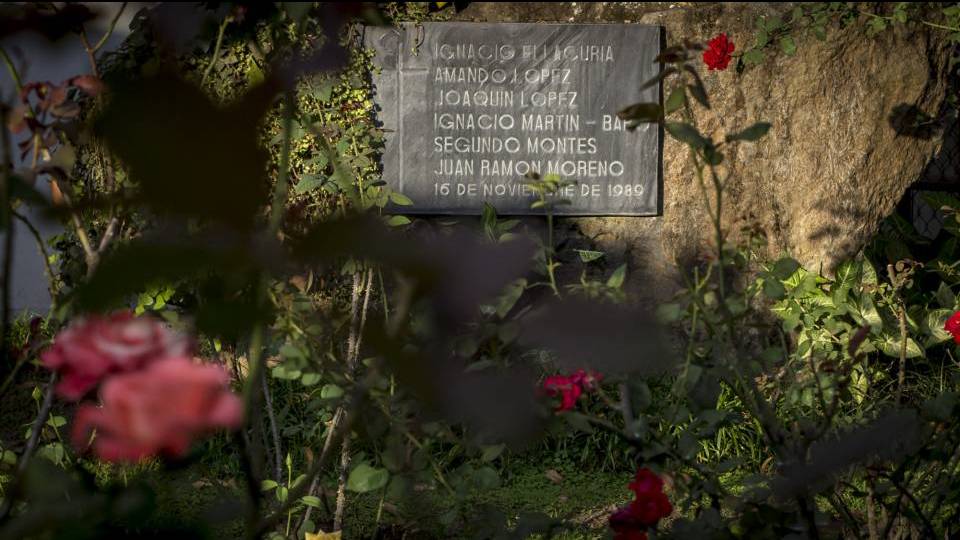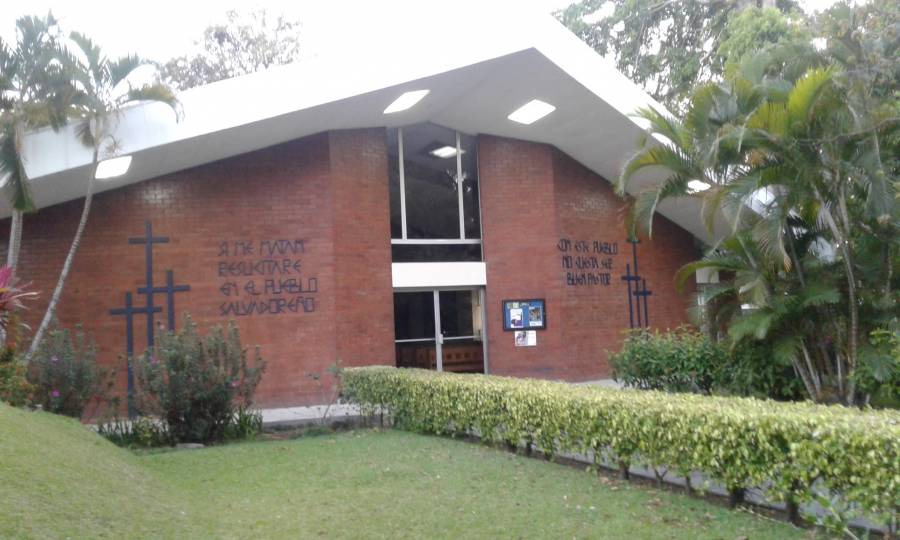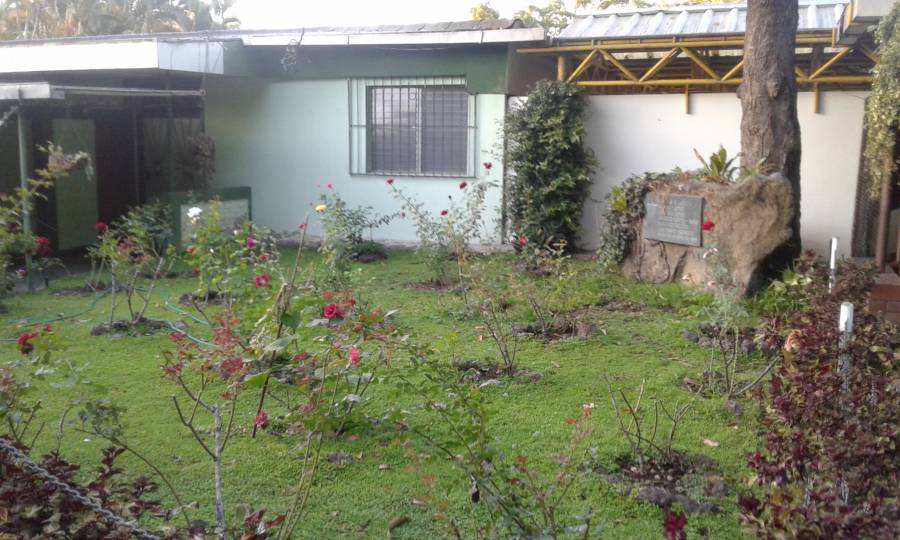



Deacon-structing Martyrdom Part 2: Witnesses
Deacon Pedro
Thursday, May 31, 2018

What does it mean to be a martyr? That’s the question we tried to answer last week. It’s a question that we all need to think about because it is directly related to following Christ.
If we want to follow Jesus, He said, we must pick up our Cross. Following Jesus will always lead to the Cross.
 What I found out later was that initially the security forces were having a hard time entering the building where the Jesuits stayed. The priests woke up and let them in! They truly stood for dialogue and reconciliation.
In 1977, Fr. Ellacuría, who was the university’s president at the time, had written:
What I found out later was that initially the security forces were having a hard time entering the building where the Jesuits stayed. The priests woke up and let them in! They truly stood for dialogue and reconciliation.
In 1977, Fr. Ellacuría, who was the university’s president at the time, had written:
 A famous quote by Fr. Ellacuria is: “Do everything possible so that liberty is victorious over oppression, justice over injustice, love over hate.” That’s our call.
Fr. Jon Sobrino, SJ, who would have been killed that night had he not been lecturing in Bangkok (and who still lives at the UCA), once said,
A famous quote by Fr. Ellacuria is: “Do everything possible so that liberty is victorious over oppression, justice over injustice, love over hate.” That’s our call.
Fr. Jon Sobrino, SJ, who would have been killed that night had he not been lecturing in Bangkok (and who still lives at the UCA), once said,
 Every week, Deacon Pedro takes a particular topic apart, not so much to explore or explain the subject to its fullness, but rather to provide insights that will deepen our understanding of the subject. And don’t worry, at the end of the day he always puts the pieces back together. There are no limits to deaconstructing: Write to him and ask any questions about the faith or Church teaching: [email protected] @deaconpedrogm
Every week, Deacon Pedro takes a particular topic apart, not so much to explore or explain the subject to its fullness, but rather to provide insights that will deepen our understanding of the subject. And don’t worry, at the end of the day he always puts the pieces back together. There are no limits to deaconstructing: Write to him and ask any questions about the faith or Church teaching: [email protected] @deaconpedrogm
But does it always lead to death?
Could we argue that martyrs are necessary for the Church to bear fruit? It is if what Jesus said about the grain of wheat (John 12:24) is true. In John’s account of Jesus' Passion, which we read every year on Good Friday (John 18:1—19:42), Jesus tells Pilate that He “has come into the world to bear witness to the truth” (John 18:37). The Catechism of the Catholic Church says:“The Christian is not to ‘be ashamed then of testifying to our Lord.’ In situations that require witness to the faith, the Christian must profess it without equivocation, after the example of St. Paul before his judges. We must keep ‘a clear conscience toward God and toward men’” (CCC#2471).And this is why all of us are called to be martyrs even if we are never killed for our beliefs.
“The duty of Christians to take part in the life of the Church impels them to act as witnesses of the Gospel and of the obligations that flow from it. This witness is a transmission of the faith in words and deeds. Witness is an act of justice that establishes the truth or makes it known” (CCC#2472).
Witnesses
This is why from the beginning of the Church, there have been martyrs – “witnesses” is the word in Greek. Right from the beginning of the Church (and even in the Old Testament -look at the Book of Daniel and the Book of Maccabees), there has been an understanding that humans have a choice between life and death and we are to choose life (Deut. 30:19). With Jesus’ death and resurrection, there is a renewed understanding that choosing life sometimes means our own death. I did a quick internet search for a list of Catholic martyrs and was surprised that there is in fact a Wikipedia entry for Christian martyrs. I’m sure it is not a complete list, but a quick glance shows that right from the beginning, from the deaths of the Holy Innocents and John the Baptist and then St. Stephen and St. James, whose martyrdoms are mentioned in the Book of Acts, to SS. Peter and Paul and all the Apostles (except for St. John), SS. Polycarp and Justin, St. Lucy, St. Lawrence, St. Cecilia, and St. Joan of Arc in the Middle Ages, the Church has been fed by the blood of the martyrs. In fact, already in AD 197 Tertullian was writing that famous phrase in his Apologeticus: “The blood of the martyrs is the seed of the Church.”El Salvador
Last time I mentioned that we had just returned from El Salvador, where during their civil war of the late 70s and 80s, the Church suffered a severe repression which resulted in the deaths of 17 priests, 4 women religious, 2 bishops, and 1 seminarian, and the deaths of some 75,000 Salvadorians. One of the women we interviewed for The Francis Impact is Ana Ortiz. Ana told us about her eldest brother, Fr. Octavio Ortiz – the first priest ordained by Monseñor Romero – who was killed with four young men while running a retreat. Fr. Octavio was 34 years old. That night he had arrived at the retreat home eager to spend the next day, Sunday, with the young people reflecting on Luke 4:18:“The Spirit of the Lord is upon me, because he has anointed me to bring good news to the poor. He has sent me to proclaim release to the captives and recovery of sight to the blind, to let the oppressed go free.”
That was the theme of the retreat.
Around 6am, security forces arrived at the house in several vehicles and a small tank. They began shooting as the retreat participants, frightened by the noise, were getting out of their beds. Fr. Octavio was run over by the tank, his completely destroyed and unrecognizable body left in the courtyard. When they were done, David Caballero, 16; Angel Morales, 22; Roberto Orellana, 16; and Jorge Gomez, 22, were dead alongside Fr. Octavio. The rest of the participants were all arrested. Their crime? Working for the community and the Kingdom despite the violent persecution of the Church. What Ana didn’t tell us, but I found out later, was that her other four brothers were also all killed by government forces over the next 10 years.Working with the Poor
I remember, in December 1980, when we heard the news that four American women had been killed in El Salvador. They were Maryknoll Sisters Ita Ford and Maura Clark, Ursuline Sister Dorothy Kazel, and a lay missionary Jean Donovan, 27, who was engaged to be married. They were abducted, raped, and brutally executed by the Salvadorian Death Squads. Their crime? Working with the poor and oppressed people in rural areas – which the government considered a subversive threat to their right-wing capitalist ideologies. While these murders were a wake-up call to many in the US, the Reagan administration discounted them so as not to risk funding of aid to El Salvador.Witnessing to Truth
Most of the time we were in El Salvador was spent at the UCA, the Universidad Centroamericana José Simeón Cañas, a Jesuit institution. I also remember, in 1989, when six Jesuit priests were brutally killed in El Salvador. They were killed at the UCA. In the early hours of the morning of November 16, 1989, an elite unit of the Salvadoran Army entered the grounds of the University. When the soldiers left, six Jesuits lay dead. Frs. Ignacio Ellacuría, Ignacio Martín-Baró, Segundo Montes, Juan Ramón Moreno, Joaquín López y López and Amando López had been advocates of a negotiated settlement between the government and the Guerilla Front that had been fighting the government for a decade. Along with the six Jesuits, two women were also killed: their housekeeper, Elba Ramos, and her 16-year-old daughter, Celina Ramos.
The chapel at the UCA where the 6 priests and the 2 women are buried. Only a few steps away is the residence where they were killed.
“Jesus does not preach an abstract or purely beyond-earthly Kingdom of God, but a concrete kingdom, which is the contradiction of a world that is structured by the power of sin; a power that goes far beyond the heart of man and that becomes historic and structural sin.”
It was that power of sin that caused their martyrdom.
It is that power of sin that we are all called to oppose. We are called to be outspoken against it and always stand up against it. Even if it means that we will be mocked, ridiculed, criticized, attacked, banished, or yes, even killed.
The garden outside the residence where five of the Jesuits were killed. It is now a rose garden.
“The Resurrection of Jesus is...a symbol of hope...I don't see how you can show love...without being in solidarity with the victims of this world. And if you are in solidarity with the victims, I don't see how you can avoid the cross. The theology of the cross is the theology of love in our real world.”Let’s remember that: the theology of the cross is the theology of love. Martyrdom is like love: it is giving it all. It may not mean death for most of us, but we are still called to give it all. Even unto death. - Read more about the Jesuit Martyrs of El Salvador. For more on El Salvador and Archbishop Romero, visit our Romero page.
 Every week, Deacon Pedro takes a particular topic apart, not so much to explore or explain the subject to its fullness, but rather to provide insights that will deepen our understanding of the subject. And don’t worry, at the end of the day he always puts the pieces back together. There are no limits to deaconstructing: Write to him and ask any questions about the faith or Church teaching: [email protected] @deaconpedrogm
Every week, Deacon Pedro takes a particular topic apart, not so much to explore or explain the subject to its fullness, but rather to provide insights that will deepen our understanding of the subject. And don’t worry, at the end of the day he always puts the pieces back together. There are no limits to deaconstructing: Write to him and ask any questions about the faith or Church teaching: [email protected] @deaconpedrogmRelated Articles:
<<
SUPPORT LABEL
$50
$100
$150
$250
OTHER AMOUNT
DONATE
Receive our newsletters
Stay Connected
Receive our newsletters

Stay Connected







